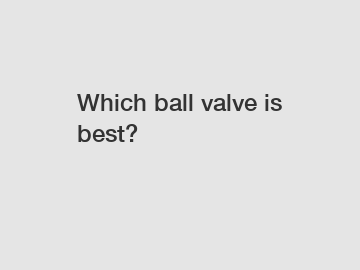Which ball valve is best?
Which Ball Valve is Best?
When it comes to ball valves, there are several types available in the market. Each type has its own set of features and benefits, making it crucial to understand which ball valve is best suited for a particular application. In this article, we will discuss the different types of ball valves and their uses, helping you make an informed decision.
1. Full Port Ball Valve.

A full port ball valve, also known as a full bore ball valve, has a bore diameter equal to the pipe's inner diameter. This type of valve provides minimal flow restriction, making it ideal for applications that require maximum flow rates. Full port ball valves are commonly used in industries such as oil and gas, chemical, and water treatment, where flow efficiency is critical.
2. Reduced Port Ball Valve.
Unlike the full port ball valve, the reduced port ball valve has a smaller bore diameter. This design allows for a smaller ball and stem, making it more cost-effective and lighter in weight. Reduced port ball valves are suitable for applications that do not require high flow rates or where space and budget constraints are a concern.
3. V-Port Ball Valve.
A V-port ball valve features a v-shaped ball that provides a precise flow control characteristic. This type of valve is often used in applications that require accurate modulation or throttling of the flow, such as in the control of temperature, pressure, or level. V-port ball valves find applications in industries like refining, pulp and paper, and food processing.
4. Trunnion Mounted Ball Valve.
Trunnion mounted ball valves feature additional mechanical anchoring of the ball at the top and bottom, offering greater stability and reduced wear on the seats. These valves are commonly used in applications that involve high pressure or high temperature, where the ball needs additional support. Trunnion-mounted ball valves are typically found in industries dealing with oil and gas transmission, power generation, and petrochemical.
5. Floating Ball Valve.
Floating ball valves rely on the downstream pressure to provide sealing. The ball is free to move vertically within the valve body, allowing it to seal against the downstream seat under the effect of pressure. This type of ball valve is commonly used in low-pressure applications where positive sealing is not as critical.
Closing Paragraph:
In conclusion, choosing the best ball valve depends on the specific requirements of the application. The full port ball valve is ideal for applications where maximum flow rates are essential, while the reduced port ball valve offers a more budget-friendly option. The V-port ball valve provides precise flow control, and the trunnion-mounted ball valve offers stability in high-pressure environments. The floating ball valve, on the other hand, suits low-pressure applications. For further assistance in selecting the right ball valve for your needs, feel free to contact us.
Remember, selecting the appropriate ball valve is crucial for the optimal functioning of your systems, so it's essential to make an informed decision based on the specific requirements of your industry or application. Contact us today and our team of experts will be happy to assist you in choosing the best ball valve for your needs.
Keywords: contact us.
Want more information on wholesale ball faucets, wholesale ceramic disk faucets, wholesale hotel faucets? Feel free to contact us.
159
0
0


Comments
All Comments (0)